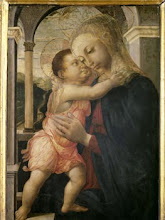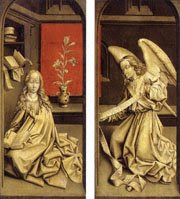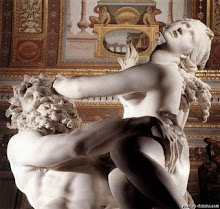





ANDREA DEL SARTO
(b. 1486, Firenze, d. 1530, Firenze)
Biography
Florentine painter. The epithet 'del sarto' (of the tailor) is derived from his father's profession; his real name was Andrea d'Agnolo di Francesco. After an apprenticeship under Piero di Cosimo he soon absorbed the poised and graceful style developed by Fra Bartolommeo and Raphael in Florence during the first decade of the 16th century, and following the departures of Leonardo, Raphael, and Michelangelo (all of whom had left Florence by 1509) he became established with Bartolommeo as the leading painter of the city. Apart from a visit to Fontainebleau in 1518-19 to work for Francis I, Andrea was based in Florence all his life, although he probably visited Rome soon after his return from France, and made short visits elsewhere.
He excelled as a fresco decorator (there are outstanding examples in Florence in SS. Annunziata and the Chiostro dello Scalzo), and he also painted superb altarpieces (The Madonna of the Harpies, Uffizi, Florence, 1517) and portraits (A Young Man, National Gallery, London).
Andrea executed fresco decorations for the Servites, a religious order, in their Church of the Santissima Annunziata at Florence. By 1510 he completed five scenes depicting events in the life of S. Filippo Benizzi, a 13th-century leader of the Servite order. Many commissions followed, including the grisailles (monochromatic frescoes painted in shades of gray) of Saint John the Baptist in the cloister of the Scalzo in Florence.
In 1518 he was summoned to the court of Francis I of France, who entrusted him with money to purchase works of art in Italy. He returned to Florence in 1519 and remained there, using the money for his own purposes. In Florence, Andrea continued his work on the fresco series in the cloister of the Scalzo, which he completed in 1526. In 1525 he painted the Madonna del Sacco, which is generally considered his masterpiece, in the cloister of Santissima Annunziata. He executed his last major work in fresco, the Last Supper (1527) in the refectory of the convent of San Salvi near Florence. Among his other noted works are the Pietà (1524, Pitti Palace) and The Assumption (1530, Pitti Palace).
Andrea's reputation was largely made and marred by Vasari, who said that Andrea's works were 'faultless' but represented him as a weakling completely under the thumb of his wicked wife. In Robert Browning's poem on the painter (1855) and in a psychoanalytic essay by Freud's disciple Ernest Jones (1913) attempts are made to link a supposed lack of vigour in his mellifluous art with these traits of character. This, however, is hardly just and a good deal of Vasari's account of Andrea's private life has been shown to be factually inaccurate (the scandalmongering is mainly in the 1550 edition of his book and was suppressed in the 1568 edition).
Andrea has suffered from being the contemporary of such giants as Michelangelo and Raphael, but he undoubtedly ranks as one of the greatest masters of his time. In grandeur and gracefulness he approaches Raphael, and he had a feeling for colour and atmosphere that was unrivalled among Florentine painters of his period. He also numbers among the finest draughtsmen of the Renaissance (the best collection of his drawings is in the Uffizi). Certain features of his art foreshadow the Mannerist experiments of his great pupils Pontormo and Rosso Fiorentino. The many other artists who trained in his busy workshop include Salviati and Vasari.
























.jpg)

.jpg)










